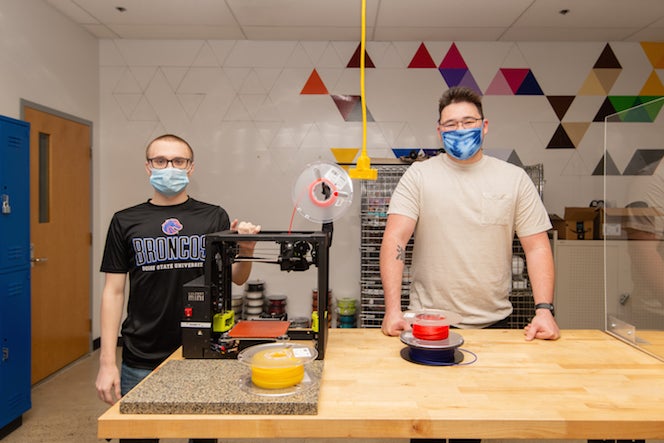
When the community put out the call for personal protective equipment (PPE) earlier this year, we shared stories of the Boise State MakerLab assembling a volunteer team to 3D print face shields.
The PPE project has wound down for now. Fortunately, the team of 3D print-savvy volunteers remains.
This spring, Idaho Educational Services for the Deaf and Blind (IESDB) asked the MakerLab to 3D print finger guards for people learning to type on a Braille writer. The guards keep a typist’s fingers from hitting more than one key at a time. The MakerLab’s 3D printers weren’t available because of the campus closure, so lab manager Amanda Baschnagel reached out to seniors Kai Lansdell and Mason Hix for help.
Lansdell and Hix, a mechanical engineering major and electrical/computer engineering major respectively, had volunteered to make PPE using their own 3D printers, a process that had their machines running 24/7 for days on end. But when the MakerLab called, they were quick to again volunteer their time and expertise. Together, they printed 20 finger guards.
“This simple 3D-produced tool can transform a regular braille writer into a great teaching tool within seconds, saving the teacher time and effort,” said Erin Rainey, a braille transcriptionist at the IESDB. “With early proper fingering skills, a student can be more productive, which will eventually lead to accessing more and more educational materials. A win-win for teacher and student.”
The 20 finger guides have been distributed to teachers of visually impaired students around the state.

“Knowing that there is a group of talented students/employees that are interested in using their tremendous talents in helping our community is reassuring. I hope that this might be just the start of a relationship that will continue as we search for more educational tools for our Idaho students,” said Rainey.
“I’ve always been happy to help those in need who can’t be helped by traditional manufacturing, or could be, but not as quickly,” said Lansdell, who grew up in Hawaii before coming to Boise State. “A project like this is an excellent use for 3D printers.”
Lansdell spent his summer working for Boise State in the New Product Development Lab where students work with clients – usually small businesses and entrepreneurs in need of engineering services like developing prototypes or connecting with manufacturers. Lansdell said he thrives on identifying a problem, then finding its “elegant solution.”
“I would like to end up in firearms or automotive engineering. But if I end up at a small firm making shovels, that would be OK as long as I get to do my engineering thing and solve problems,” he said.
Hix grew up in Boise and is finishing his second internship at Micron. This summer, he worked in memory layout for semiconductors.
“I would get told that they had a part that needed some edits so it would run faster or print on silicon better. I would move metal layers or expand lines of some material, update it so they could reprint it to work better,” said Hix.
Both he and Lansdell agreed that they’d happily volunteer their 3D printing expertise for a community cause again.
The work of Hix and Lansdell is “another example of how being at Boise State instills the desire to help,” said Baschnagel. “At the MakerLab we are always trying to fill community needs through innovation, and sometimes the most innovative thing we can do is listen and connect.”
Word of their project has gotten out, Baschnagel added.
“We’ve been able to send Braille Guides to Texas, and connect individuals in Maryland, Canada, and Nebraska to MakerLabs in their communities to make prints for them a little closer to home.”
– Story by Anna Webb